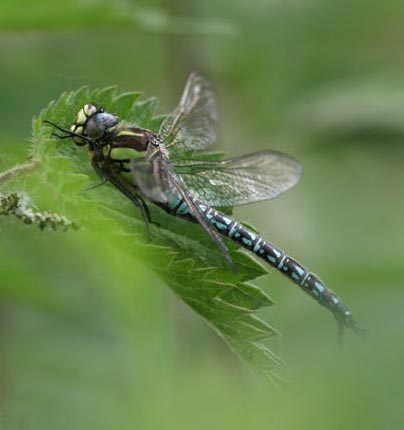- Hairy Dragonfly
Taxobox
name = Hairy Dragonfly

image_width = 250px
image_caption = Hairy Dragonfly photographed nearRiver Great Ouse ,United Kingdom
regnum =Animal ia
phylum =Arthropod a
classis =Hexapoda
ordo =Odonata
subordo =Anisoptera
familia =Aeshnidae
genus = "Brachytron "
species = "B. pratense"
binomial = "Brachytron pratense"The Hairy Dragonfly ("Brachytron pratense") is a European dragonfly of the family
Aeshnidae . It is also known as the Hairy Hawker.Description
The Hairy Dragonfly is named for its hairy thorax, distinguishing it from other hawkers. It has a long, narrow pterostigma, "a coloured, chitinous patch on the outer region of each wing." [ [http://www.habitas.org.uk/dragonflyireland/5622.htm Nelson, B., C. Morrow, and R. Thompson. Brachytron pratense. 8 May 2000. National Museums and Galleries of Northern Ireland and Environment and Heritage Service. 25 Feb. 2008] ]
It is smaller than the subspecies of Aeshnidae, Aeshna. The antehumeral stripes are usually thin and green. The Hairy Dragonfly has coupled, oval-shaped markings on its abdomen, blue on males and yellow on females. It is the United Kingdom's smallest hawker. [ [http://www.dragonflysoc.org.uk/brpra.html "Brachytron pratense - Hairy Dragonfly. 31 Aug. 2007. British Dragonfly Society. 13 Mar. 2008] .]
Habitat
The Hairy Dragonfly lives in ponds, lakes, fens, ditches, and canals rich in vegetation. Some plants that grow there include the common club rush, common reed, great fen sedge, and true bulrush. This dragonfly requires open and sunny areas with dense vegetation for protection. Here they are able to feed on flying insects, shelter, and grow sexually mature.
Although it is a common species, it is susceptible to uncongenial ditch management and poor water conditions. The is the reason the species disappeared for a few years, only to return recently. More so then its other relatives, the Hairy Dragonfly will only fly in sunshine and will hastily retreat if the sun happens to go in.
Food and feeding Habitats
Many hawkers like to catch insects while in flight. Similarly, the Hairy Dragonfly preys in mid-air on flying insects. It then carries its food to a suitable place where it is able to eat and digest.
Life stages
The Hairy Dragonfly's flight period is short and early, beginning in mid-May and ending in mid-July. Dead vegetation and living stems growing in the water, close to the water's edge, provide a home for the eggs. Two years later, larvae emerge by scaling plant stems just above the surface of the water or possibly crawling inland for about a meter where they have room to spread their wings.
Notes
* [http://www.lincstrust.org.uk/species/dragonfly_damselfly/hairy_dragonfly/index.php Hairy Dragonfly. LWT (Lincolnshire Wildlife Trust). 25 Feb 2008]
* [http://www.dumgal.gov.uk/dumgal/xdocuments/5856.pdf.ashx Hairy Dragonfly: Dumfries and Galloway Local Species Action Plan. 7 Mar. 2008. Dumfries and Galloway Council]
References
External links
* [http://www.habitas.org.uk/dragonflyireland/5622.htm Brachytron pratense: National Museums and Galleries of Northern Ireland and Environment and Heritage Service]
* [http://www.lincstrust.org.uk/species/dragonfly_damselfly/hairy_dragonfly/index.php Hairy Dragonfly: LWT]
* [http://www.dumgal.gov.uk/dumgal/xdocuments/5856.pdf.ashx Hairy Dragonfly: Dumfries and Galloway Local Species Action Plan]
Wikimedia Foundation. 2010.
